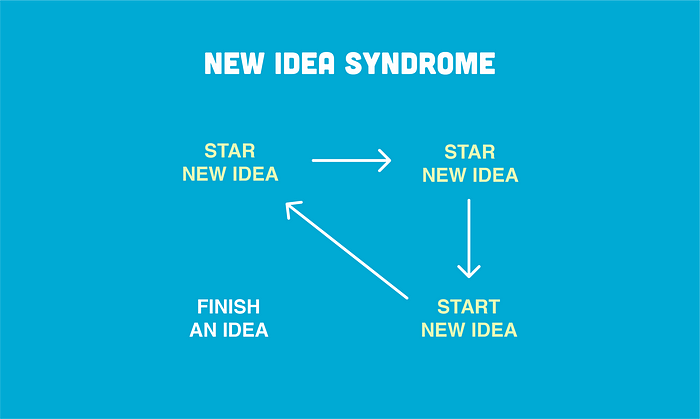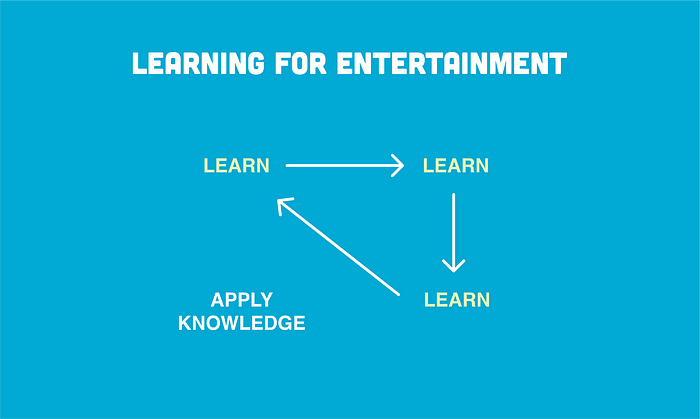

How Cyclical Breaking of Behaviors Can Overcome Your Creative Struggles
source link: https://uxplanet.org/breaking-cycle-behaviors-93f6303555d9
Go to the source link to view the article. You can view the picture content, updated content and better typesetting reading experience. If the link is broken, please click the button below to view the snapshot at that time.

How Cyclical Breaking of Behaviors Can Overcome Your Creative Struggles

At times, individuals face a state of mind that discourages creativity. This could be due to various reasons such as writer’s block, designer’s impasse or even general uninspired feeling; ultimately leading to an arduous creative process.
A common barrier is allowing our thoughts to take precedence over our actions, resulting in being stuck. As a User Experience Mentor, I’ve come across many students facing the same challenges. This occurs because we fail to prioritize action and instead prioritize thought processing to succeed.
Here are a few visual examples of how cycles can impair to flow of your potential and how to overcome them by recognizing the patterns that keep you stuck:
OVERTHINKER

Do not judge your thoughts.
Fill your mind with novel notions from different perspectives without classifying their inherent qualities as good or bad. Vary the content of what consumes you mentally to foster creative thinking and strengthen mental flexibility. Avoid limiting yourself by attaching labels such as favorable or unfavorable, but embrace all ideas equally regardless of subjective evaluation.
Upon your initial abundance of inspiration, it is time to initiate the organization's process. Developing designated periods dedicated to ideation and producing cognitive maps can assist in sorting thoughts applicable to said project.
It's possible to uncover unanticipated correlations and opportunities that could ultimately result in inventive resolutions by undertaking this initiative.
Don't trust your memory.
Using a tool other than memory can enhance the record-keeping of innovative procedures by supplying precision, reusability, answerability, partnership, and educational chances. Through recording these processes, you are securing an all-inclusive and dependable account of what took place, which has the possibility to lead towards superior results in future endeavors.
The act of recollection is prone to error, and it’s not difficult to overlook crucial particulars or stages in the imaginative procedure. By recording occurrences as they happen, you guarantee precision and entirety when documenting said occasions.
Think less. Experiment more.
Rather than excessive contemplation of your project, concentrate on initiating action. You can start with a minor undertaking and progress gradually from thereon. By fragmenting the venture into smaller chores, you can dedicate yourself to individual concerns at intervals while ensuring that it is simpler to undertake negligible activities and abstain from overthinking things.
Take some time out of your mind.
Analyzing too much might sometimes imply that it is time for you to rest. Cease your labour briefly and partake in an alternative undertaking or perform something unrelated to free your mind of clutter. Engaging in novel activities can help stimulate brain function while disrupting mental patterns. By returning back after this break, there’s the possibility of gaining renewed vision and readiness towards undertaking minor actions on the project at hand.
Shift from uncertain to justifiable decision-making.
The pressure of taking action can lead us to postpone the decision. This makes us feel paralyzed. An effective method to transform the anxiety of making a choice into one that holds merit is by amassing copious amounts of pertinent data concerning the undertaking and meticulously analyzing both advantages and disadvantages for each feasible selection.
In order to avoid decision bias, it’s essential to rely on sound evaluation methods. By concentrating on facts and figures instead of emotions or feelings, you can make an enlightened, more logical choice. Keep in mind that most discoveries are adaptable; they can always be amended as time passes by, so do not fret over making the “flawless” judgment from the initial stages. In lieu thereof, go for a fully informed verdict while simultaneously being receptive towards modifications throughout the progression of your project if necessary.
Every now and then, an abundance of alternatives may cause excessive contemplation. Consequently, setting boundaries for your undertaking by determining criteria, collecting data and investigating can enhance the quality of your judgement.
NEW IDEA SYNDROME

Don't wait for your 'Eureka Moment.'
Rather than waiting for a spark of creativity, consider dividing your undertaking into bite-sized and feasible objectives. Such an approach can help to amass energy gradually and increase assurance as you accomplish every target.
Many accomplishments that are noteworthy seem to derive from putting in a lot of effort and staying the course, rather than being built on an exceptional notion alone.
Although the conception of novel ideas is significant, it holds as much significance as actualizing and finalizing them. Without execution, ideas are just dreams.
Use mental models.
Mental models are structures that assist in your cognitive process to analyze and tackle issues systematically. A case in point is the “primary tenets” blueprint, which directs you to dismantle a problem into its basic elements, subsequently constructing a resolution using those building blocks.
The ideas individuals formulate are often influenced by their personal biases, and acknowledging them can present a challenge. Nonetheless, taking a practical approach may aid people in evaluating these concepts based on their effectiveness or feasibility instead of subjective opinions. A conscientious examination of the idea lies behind objective assessments that allow for evidence-based decision-making instead of preconceptions while prioritizing what has been tested in practice.
Identify relevant ideas ignoring distractions.
Prioritizing concepts during the creative process is crucial, although it is not easy when faced with the “shiny object syndrome.” This condition pertains to being sidetracked by novel and captivating notions, even if they are not of utmost significance or appropriateness.
Sometimes, our fixation on an idea or concept is so intense that all else fades away from plain sight.
In order to combat this syndrome, it is crucial that a person must establish unambiguous objectives and priorities. They should also implement time constraints while concentrating on significant undertakings to avoid being sidetracked by avoidable interruptions. Consequently, recognizing whether an idea or project has merit for the long haul versus being momentary in nature is fundamental knowledge when identifying where attention should be directed.
Stay open-minded.
Although it’s crucial to remain attentive toward the aims of your project, having a receptive attitude to novel concepts that could advance its development is also vital. Allow yourself to entertain new perspectives that correlate with the task's objectives and have potential to enhance it as well.”
One approach to preserving an open attitude is by staying pliant and versatile. Ventures often ensue in unforeseen ways, presenting unique difficulties or doorways for advancement. Being adaptable and receptive to different potential outcomes enables tackling these obstructions head-on while furthering the project’s prosperity.
LEARNING FOR ENTERTAINMENT

What's holding you back from starting?
It can be daunting to start something fresh, primarily if it’s a new experience. Dread of disappointment or ambiguity might impede you from initiating the first move.
Supposing that it’s apprehension surrounding failure, incompetence in the area where you intend to improve yourself, or merely lacking a processor as your guide; dividing an immense assignment into minor constituents offers scope for concentrating on precise errands at any moment.
Stop overthinking it and just get started.
Greater confidence to grow.
By eliminating misunderstandings and establishing a firm understanding, one can elevate self-assurance and become more emboldened to take on an undertaking. The resulting assurance has the potential to act as fuel for maintaining determination, concentration, and dedication toward aspirations, even during challenging situations.
Active learning.
Learning actively implies immersing in the concepts and placing them in realistic circumstances. Opt not to aimlessly scroll through unlimited tabs; instead, interact by inscribing down notes, influencing inquiries, and thoughtfully analyzing how it can be employed correspondingly for your being. In effect, this will aid in retaining intelligence while simultaneously applying it toward purposeful objectives.
PERFECTIONISM

Focus on the process rather than the result.
We are trained only to show the result. However, the procedure to achieve a goal holds greater significance than its final fruition.
Orienting oneself towards the sequence of actions required is conducive to putting in the necessary time and labor, ultimately resulting in excellent outcomes.
One may find that this approach aids in cultivating self-assurance and a sense of progression while striving towards attaining said undertaking.
Recognize the strides you’ve made, even if they appear minor — this can encourage and concentrate your efforts.
Reframe failure.
Perfectionism can create a fear of failure, hindering growth and progress.
Reframe failure as an opportunity to learn and improve rather than negatively reflecting your abilities is the key. A method to achieve this goal is recognizing that errors and obstacles are fundamental to gaining new insight. Bungles and snags are certainties that every individual will face throughout their existence, without any exemptions.
Rather than interpret defeat as indicative of one’s shortcomings or fragility, leverage it for personal development and progress.
Allow room for experimentation.
Exploration is an essential element in the imaginative procedure. Provide yourself with free rein to explore varying concepts and methods without any concern about perfecting them on your initial attempt.
It’s essential to prioritize creativity and innovation, even in a fast-paced environment. This means carving out time for idea generation and creating a culture encouraging experimentation and risk-taking.
It frequently turns out that the most prosperous undertakings arise from diligent labor and persistence, rather than a merely exceptional notion.
Be always beta.
I don’t know what moment in your life you live or what challenges hinder you from acting, but one certainty we have: it’s worth trying.
By recognizing the patterns that keep us stuck and making intentional changes is the start of breaking free from cyclical behaviors.
Do you accept the challenge?
Thanks for reading!
If you would like to discuss more, share feedback or ask any questions, drop me a line or connect with me on LinkedIn.
The inspirations for my article came from them: Janis Ozolins, Darius Foroux, Liz Fosslien + Mollie West Duffy, Thomas Frank, and Joseph Nguyen.
Recommend
About Joyk
Aggregate valuable and interesting links.
Joyk means Joy of geeK